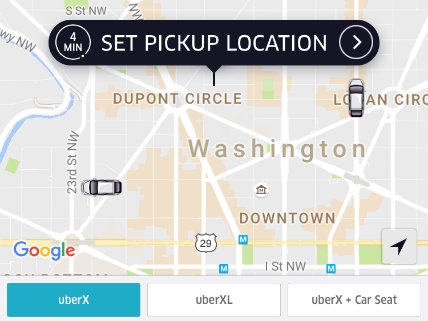With Ride-Sharing Technology, Cities Will Build On-Demand Bus Lines Around You
Ask not for whom the bell tolls, mass transit agencies of America.

Uber has become a ubiquitous part of urban America, but the capitalists who disrupted the taxi cartels aren't done changing the way we get around. The next step in the Uber-ization of transportation will see ride-sharing services taking on mass transit agencies—and if you thought the taxi industry was long overdue for a major shake-up, get ready for an even more stunning transformation.
Transit options that can serve individuals better than buses and move mass numbers of people with greater efficiency in ever-more-crowded cities are better for consumers, of course, but it's also a good deal for city governments.
Bloomberg reported this week on how Pinellas Park, a suburb of Tampa, Florida, is already partnering with Uber and Lyft to run two bus lines for about $40,000, or about a quarter of what it was spending to run those two bus lines previously.
Interestingly enough, the experiment with ride-sharing-as-mass-transit in Pinellas Park would never have happened if city officials had their way. In 2014, voters rejected a plan to increase taxes to pay for upgrades to the bus system and to build an expensive new light rail line.
Some Miami suburbs and a town near Denver, Colorado, are considering similar arrangements, Bloomberg reports.
The coming mass transit disruption will take on different forms in different places. The Bloomberg article focuses on how some cities are partnering with Uber and Lyft to replace smaller bus lines and to provide a better feeder system for existing mass transit, but there are already indications that ride-sharing services could beat mass transit agencies at their own game.
Uber is already doing this—more or less—in places where it has rolled out the Uber Pool option. Uber Pool uses algorithms to link up users' pick-up and drop-off locations, allowing a single driver to give multiple rides simultaneously along the most efficient route. Essentially, Uber builds brand-new bus lines in real time, responding immediately to supply and demand.
One of Uber's long term goals is to lower its price point until grabbing a ride with your smart phone is cheaper and easier than driving or taking a bus, as I detailed earlier this month. That means fewer ugly parking garages and more useful space in downtowns, more good news for America's cities.
Other ride-sharing services are following that model to develop a middle ground between Uber and civic mass transit services. Bridj, a startup private bus service, uses no fixed lines and responds to demand by rerouting buses in real time.
Government-run transit agencies can't even begin to compete with that sort of thing. Even if they had the ability to re-route buses on demand, other forms of mass transit (like those billions of dollars' worth of light rail lines American cities have foolishly built over the past decade) have routes that are written in stone.
At least some cities seem to realize that much. Rather than trying to compete with increasingly more transit-like ride-sharing options, Kansas City bought 10 buses from Bridj earlier this year. At least 10 other cities are curious about trying similar arrangements, Bridj's CEO told Bloomberg. The bus service is also operating in Washington, D.C., and Boston.
Cities would be wise to follow the lead of Kansas City and Panella Park by finding better way to integrate ride-sharing and mass transit, rather than throwing up barriers to innovations. Just like the taxi companies that fought against the first stage of ride-sharing's evolution, the unions that represent bus drivers and mass transit workers will surely throw fits over the disruptions caused by these newer development.
Even the best civic planner can't predict the need for mass transit at such an individual level. We're so used to living in cities where we have to build our plans around the existing transit options—but Uber, Bridj and whatever comes next will make it possible to have mass transit built around us.

Show Comments (56)